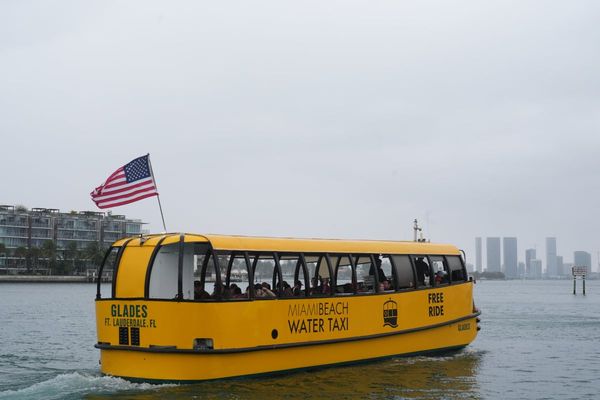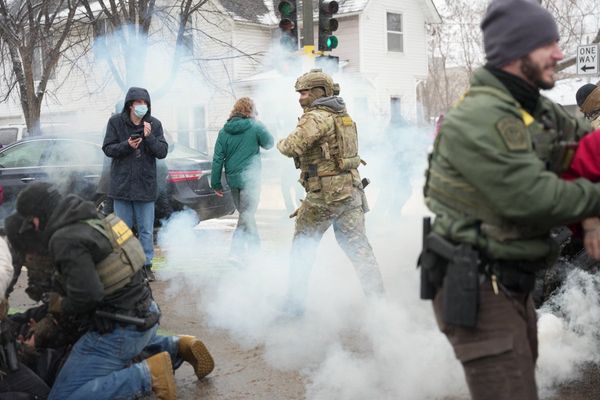
As the flood waters recede, Lismore has begun counting the cost of the devastation caused by the worst flooding in the history of the northern New South Wales town.
A flotilla of 100 boats, piloted by community members, have been going street by street alongside crews from the Australian defence force and the State Emergency Service, rescuing stranded residents.
One community member, who set out to check on the welfare of a neighbour, sadly discovered the elderly woman dead inside her home. It was the ninth death since the flood emergency began in south-east Queensland last week.
Jaala Stott is among those searching the area by boat. She says most people who were able to leave flooded homes have now gone, and rescuers are now checking the homes of people considered to be missing.
“It’s just devastation. Absolute devastation,” she says.
Stott went out in an aluminium shallow-bottomed motorboat on Monday and picked up an elderly woman with Parkinsons who was “unsteady and freezing cold”, a mother and young child, and a “huge big fat dog”.
The rescue efforts were coordinated via Facebook, but those requests have died down. The ADF is now attempting to coordinate local and emergency services resources to thoroughly check over the town. The SES conducted 230 rescues in the northern rivers region on Tuesday, spokesperson David Rankin says, but the ad hoc nature of the effort in Lismore means the exact number of people rescued is not yet known.
The floods have taken out the electricity and phone networks, meaning many of those stranded cannot contact anyone for help. People who reported being stranded in their homes on Monday have gone silent, leaving their families frantic.
Logan Madley headed out on her kayak at 7.30am on Tuesday to check on her elderly neighbours who had not been heard from since Monday. She found them sheltered in a boat behind their flooded house, reluctant to leave. The flood waters had killed their animals and destroyed their home – they wanted to stay and see what remained when the water receded. Madley gave them some supplies – panadol and non-perishable food – and caught a lift with a group of locals going by in a tinnie. They towed her kayak home.
A lack of power and access is hampering efforts to reconnect the phones.
“We are working with power and local authorities to access the affected areas so we can begin to restore services,” Telstra’s northern NSW regional general manager, Michael Marom, says.
It’s the fourth disaster to hit the Lismore region in five years, after floods in 2017, bushfires in 2019, and the economic hit from Covid.
For some, it may be the last straw. Adam Bailey owns an antique store on Woodlark Street, just 400 metres from the Wilsons River. It flooded in 2017 and again in 2020.
“I can’t be insured, I’ve lost everything,” he says. “So whatever I’ve got is whatever I can save.”

Bailey spent Sunday moving his antiques to the second floor, placing them above the high-water mark of 12.15 metres reached in the 1974 floods. The Wilson River peaked at 14.4 metres on Monday. “All that stuff’s disappeared,” he says.
His store was still under water on Tuesday morning, despite the water dropping to 12 metres overnight. The waters are not expected to fall to below the major flood level of 9.7 metres until Tuesday afternoon, but the 10.6m high flood levee will prevent many low-lying areas from draining away.
“Lismore will essentially become a bath tub, the water will be stuck behind that levee and will have to be pumped out which may take a number of days,” Rankin says.
Bailey headed out on a tinnie on Tuesday morning, boating down the main street of Lismore where the water was still lapping at second-story windows, to see his business It is behind the levee, so it will be several days before enough water has been removed to assess the damage.
The estimated value of his stock is more than $500,000. One piece alone was worth $50,000. “I love Lismore, the people in Lismore, the community, it’s amazing,” Bailey says.
“But it’s just one of those things where you’re thinking, do we do it again? In another two years, three years, we’ll have another natural disaster and I’m back at square one.”
‘Everything I’ve ever owned is in that house’
Philip Cook was up until 4am trying to secure his furniture. He stayed back after his partner, children and their new puppy went to a friend’s house.
“Everything I’ve ever owned is in that house. We’re insured for the house not the contents.”
Cook and his family recently moved to Lismore from Murwillumbah, a town about 50km north on the Tweed River. They bought the house in December and were told it had never flooded.
Downstream, in Ballina, the flood waters are yet to arrive.
Ballina is at the mouth of the Richmond River, of which Wilsons River is a tributary. The flood waters from both catchments will drain through the town into the sea. If the river’s peak coincides with a 1.8 metre king tide, at 9am on Wednesday, the town could experience a one-in-500-year flood event.
The Richmond River reached its forecast peak of 6.9 metres at Woodburn at 3pm on Tuesday and was still rising. That water will take four hours to flow downstream to Ballina, arriving about the same time as the evening high tide of 1.3 metres.

The water was touching the bottom of the windows at Peter McWilwain’s house in West Ballina on Tuesday morning, before draining away. He spent Tuesday afternoon trying to secure sandbags to prepare for the water to rise again that night and through Wednesday morning. The SES advised him to evacuate on foot. But with three children, two dogs, and his two elderly parents nearby, he is staying put.
McWilwain has lived in the house since 1997. He’s seen floods before, including one where water lapped at his garage, but nothing like this. “Tomorrow is going to really be the worry,” he says.
A short distance away, Ian Paterson surveyed the flood waters on his kayak. His family has lived in the same house in Crane Street for 80 years. The waters came within a foot of his front door on Tuesday before receding. He is hoping enough water will have drained away before high tide to avoid significant damage, but moved all his furniture into his brother’s house, one metre further off the ground, just in case.
He says past flood events may no longer be a reliable guide of the areas susceptible to flooding because the significant number of new developments in the town in the past 20 years. “It has changed where the water goes,” he says.
Evacuation ordered
An evacuation order was issued for Ballina on Tuesday morning. The SES rescued half a dozen people who were trapped in flooded homes or who had driven into flood waters.
The Ballina shire council mayor, Sharon Cadwallader, says a number of rural properties south of the town have flooded. The shire has effectively been cut off, with the airport flooded and closed to all but emergency aircraft and the Pacific Highway cut both north and south of the town due to rising flood waters.
“Ballina is certainly in a terrible situation facing a one in 500-year flood but we are holding our own,” she says.
“We are seeing flood levels we’ve never seen before. It is higher that the 1974 and ’54 floods.”
Cadwallader asked locals not to drive boats through flooded streets for sightseeing, because the wake can push more water into homes and businesses.
“There is a great community spirit out there. Offers of help are coming from everywhere and we are a resilient community and we will get through this together.”







